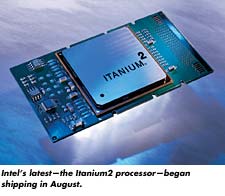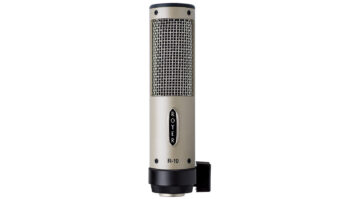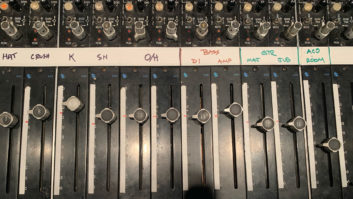
Chips, they’re everywhere: in your toaster, in your car (quite afew, in fact) and, of course, in your DAW. This month, we begin atwo-part series to revisit the age-old PPC vs. Intel debate and lookinto the new 64-bit crop of CPUs, which will have a significant impacton host-based DAWs.
To go forward, we must go into the past! Yes, cast your mind back tolast March, when “Bitstream” discussed single- vs.double-precision DSP processing. If you recall, run-of-the-mill DSPstypically store numbers as a floating-point, 24-bit mantissa and an8-bit exponent. Some fancy-pants DAWs double up the data and performdouble-precision calculations, with a 48-bit mantissa and a 16-bitexponent. This larger number of significant digits allows more signalprocessing to be performed before rounding errors are introduced.
Okay, fair enough. But to generalize, most arithmetic processes aremore precise with double the word length, including the general-purposeCPUs that are the soul of Win and Mac computers. In Windows world,those general-purpose Intel CPUs we take for granted began theirevolution as the 4004, introduced in 1971. The 4-bit 4004 wasn’t muchfun, but its children — the 8-bit 8008 (introduced the followingyear) and the 8080 (in 1974) — paved the way for the 8086, which,it could be argued, spawned the whole personal computer industry. The8086 ran its 16-bit words at a blazing 5 MHz, could address a fat 1 MBof memory and formed the computing core of IBM’s first PC. MITS’Altair, the first personal computer, used an 8080 and came to market in1975 for $395. Notice the trend: 4, 8 and then 16-bit computers. By themid-’80s, Intel had a 32-bit processor: the 386.
By the early ’90s, Intel was working on the first Pentium, and usersof the other common flavor of microprocessors — Motorola’sMC68000 Series — realized that they also needed a next-generationshot in the arm in order to compete. In 1991, Motorola, IBM and AppleComputer formed the PowerPC (PPC) Alliance, and so the PPC’s RISCy yingto Intel’s CISCy yang was born. Though the first product of the PPCAlliance, the 601, was a 32-bit microprocessor, it had both 32- and64-bit registers and a 64-bit FPU (Floating Point Unit).
Four years later, the PPC Alliance released the second-generation620. With 64-bit internal data paths and 32-bit I/O, it was the first(though partial) 64-bit implementation of the PowerPC architecture andset the stage for things to come. In a very smart move, the PPC familywas designed as a 64-bit cruncher with backward binary-compatibilityfor 32-bit applications. It would take awhile for Intel to learn thebackward-compatibility lesson, but, with the ability to chop itsspectacular profit margins and still make a tidy penny on its CPUs,Intel countered the PPC threat with lower prices, while starting adizzying spiral of ever-increasing clock rates to compensate forinherent CISC performance limitations.
A big physical difference between the PPC and the Pentium is thePPC’s Reduced Instruction Set Computing (RISC) character. Relative toCISC (Complex Instruction Set Computers), like the original Pentium,RISC architecture — with fewer instructions baked into silicon— sacrifices complexity for increased speed: the lean and meanapproach. Another factor, according to IBM, was that “…thePower Architecture was unique among the [six] existing RISCarchitectures in that it was functionally partitioned, separating thefunctions of program flow control, fixed-point computation andfloating-point computation.” The architecture’s partitioningfacilitated the implementation of a “superscalar design,” anow-ubiquitous feature, which made it possible to execute multipleinstructions during a single clock cycle. Intel, while clinging to itsx86 architecture, has its own superscalar family called the i960, whichis used for embedded application and not general-purpose computers likethe Pentium. Not to be outdone by the competition, the Pentium hasincreasingly cribbed pages from its i960 brother, adding a RISC corewith CISC trimmings to make it backward-compatible with older x86processors.

However, during the past decade, there is one metric that CPUpowerhouse Intel has emphasized in its saturation ad campaign: Fasteris better! Intel latched onto clock speed as the defining selling pointfor its products. Unfortunately, clock speed alone is a false measureof real-world performance and can only get you so far, becausearchitectural decisions by the Intel design team have forced them toramp their clock to the limits of heat dissipation in order to improveexecution. Indeed, current draw (and subsequent heat generation) is thelimiting factor in the go-fast world of Intel. It’s not uncommon tofind all sorts of exotic cooling methods used by manufacturers andhobbyists to keep their Pentiums from doing a “Three MileIsland” on the motherboard: Heat pipes, active refrigeration(both solid-state Peltier heat pumps and old-school compressed gasversions) and even water cooling has been pressed into service to chillthose huge, power-hungry chips.
When asked about the current range of 32-bit Intel processors andhow they hold up to current PowerPCs, digital audio pioneer James A.Moorer (now of Adobe Systems) doesn’t have any qualms about statingthat, “the PPC is light years better and faster than any of theothers. The P4 [Pentium 4] is pretty close, but still quite a ways off.The big thing is that the PPC chip has 64-bit data paths, andall of the Pentium chips are 32-bit data paths only. That makesthe PPC chip more than twice as fast; it yields more than twice thedata rate. Every benchmark I’ve done comes out with a difference of afactor of four times over the fastest single-processor Intel processorI could find. My benchmark is pure double-precision, floating-pointcrunch-power, with big, sprawling data structures. My FFT routine [FastFourier Transform, the basic math trick that powers all audio DAWs]generally incites the worst-case behavior of most processors’address-prediction hardware.”
Address prediction? The whole PPC vs. Intel debate, in a way, boilsdown to prediction and how designers go about auguring upcomingprocessing requests. However, that discussion will have to wait tillnext month. The stage is set to discuss a chip feature that mainframe,scientific workstation and Apple customers have long enjoyed: 64-bitand longer data words. Longer is better for “sprawlingdata structures,” and such big-league computing is starting tomake an impact on the Windows desktop, as well.
Next month, we’ll delve further into the Intel vs. AMD and Itaniumvs. Opteron tussle, while looking at IBM’s 970, the fifth-generationPowerPC destined for Big Blue’s servers and Apple’s new PowerMacs.
Drop bywww.seneschal.netfor deeper threads andillustrations concerning this month’s topic.






